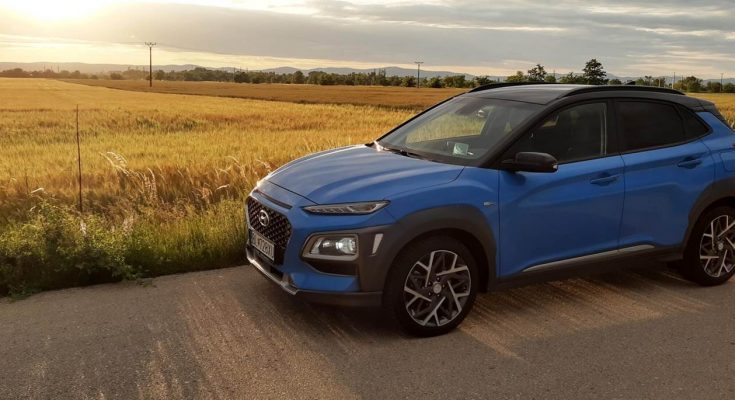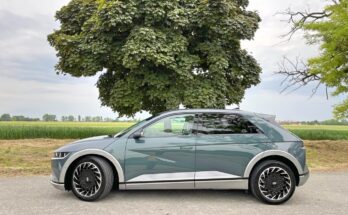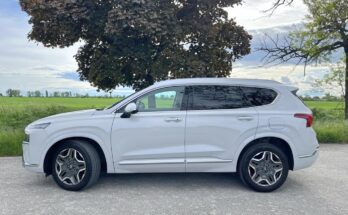A small crossover, i.e. a cross between a small SUV and a hatchback, the Hyundai Kona first came with regular combustion engines under the hood and then received the improved technology of the fully electric Ioniq. So now, after the usual motorizations followed by the electric car, the hybrid has come to the fore. So let's first look at the technical (and theoretical?) parameters of the Hyundai Kona Hybrid…
The classic Hyundai Kona probably doesn't need much introduction. It is a popular urban crossover, which, due to its ratio of compact dimensions and generous interior space, is especially suitable for city traffic. In terms of external dimensions and especially its length (4,165 mm), the Hyundai Kona belongs to the class of small vehicles. The width of 1,800 mm and the wheelbase of 2,600 mm and the generous interior space place it more among compacts. The luggage compartment has a volume of 361 liters, which is a little more than small hatchbacks usually have.
And especially in the city, the hybrid one makes much more sense than traditional drives. This expansion of the offer is therefore a logical step from the car company, and while the electric Kona received significantly improved technology compared to the Ioniq (a significantly larger battery and higher power, both with the option of choosing between two variants), the Kona Hybrid has the same drive system parameters as the Ioniq- om Hybrid. Therefore, Hyundai used already developed and proven technology in the body of the Kona, which works reliably in another model.

But let's go to the most important and most interesting thing we have here… technology.
Under the front hood, the Hyundai Kona Hybrid hides an atmospheric gasoline 1.6 with direct multi-point fuel injection, which works in the Atkinson cycle. It has a power of 77.2 kW, a torque of 147 Nm. Surprisingly, we do not find a CVT transmission here, but a classic six-speed automatic double clutch labeled DCT. The hybrid drive is complemented by a synchronous electric motor with a power of 32 kW and a torque of 170 Nm. The total output of the hybrid system is then 104 kW (141 hp) and a decent torque of 256 Nm. Thanks to this, the Kona hybrid accelerates from 0 to 100 km / h in 11.2 s (with 18 "wheels in 11.6 s) and ends acceleration already at 160 km / h.
For all of us, the most important figure for a hybrid is fuel consumption. It varies according to the equipment and according to the conversion from WLTP to NEDC it is 3.6-4.0 l / 100 km in the city, 3.9-4.5 l / 100 km outside the city and 3.9-4.3 in combined operation l / 100 km. This also shows that the Kona hybrid is best suited to city traffic. But these are theoretical values…
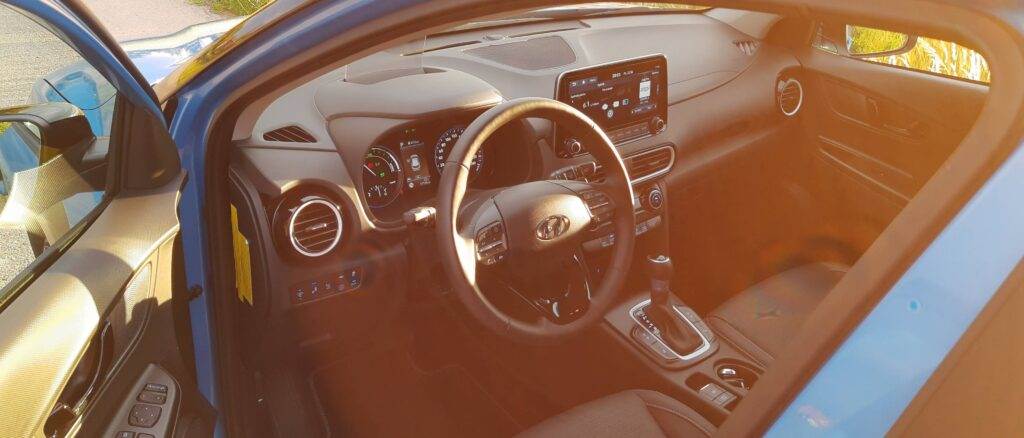
We tested the Kona for a whole week in the so-called suburban cycle, where it received a daily dose of district roads (30km), city (5-10km) and highway (15-30km). After a week, the on-board computer showed us a value of 6.1 l / 100 km, which is not bad considering the brisk driving. When driving with a light foot with anticipation and recuperation, we were able to reach the level of 5 l/100 km. Of course, the highway is always bad, as neither the weak atmospheric aggregate nor the power of the generator is enough here. The fact that the intensity of recuperation is not adjustable with the paddles under the steering wheel is also a bit disappointing. However, it can be slightly regulated simply by working with the brake pedal and thus keep the generator in the range when it charges the battery. Therefore, the Kona Hybrid stores only energy from braking or residual energy from the internal combustion engine in the battery, because the latter is more efficient when the throttle is more open, and the system sends an unnecessary part of the power to the battery, so that the car can turn off the internal combustion engine and run solely on electricity when the load is less. . This achieves that it shortens the running time of the combustion engine and if it has to run, then in a more efficient mode.

The lower fuel consumption of the Hyundai Kona Hybrid is also helped by electronic assistants. Even the basic equipment of the Hyundai Kona Hybrid (starting at the Family level) is quite rich and includes various assistants for safer and more comfortable driving. But the Eco-DAS assistant is especially interesting, which is delivered in combination with an additional 10.25" display. This should help drive even more economically, thanks to information from the navigation system about the course of the route. On the one hand, it warns the driver in time to reduce the driving speed and thereby avoid sudden braking. This function is called coast assist and can be activated at speeds between 40 and 160 km/h. Its goal is to maximize coasting or recuperation and, conversely, to minimize the use of brakes. So this function reduces not only fuel consumption but also the cost of replacing brake pads and discs.
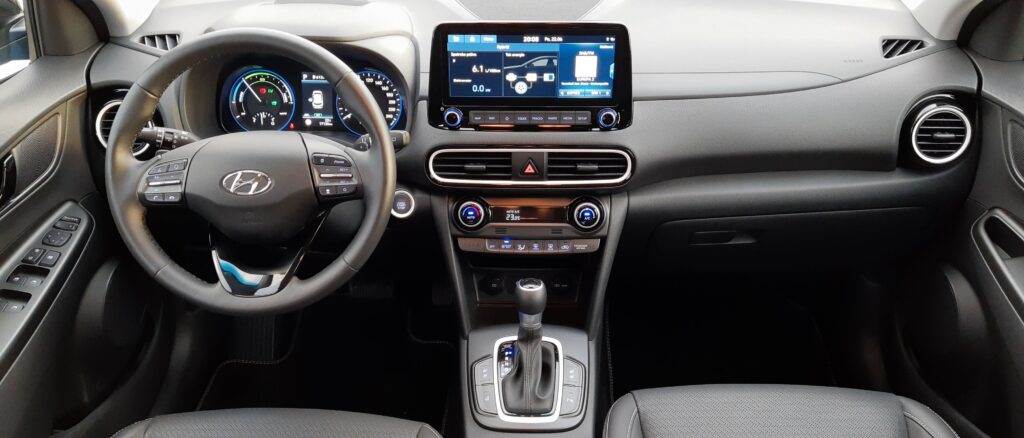
However, the above-mentioned function only works if the destination of the route is entered into the built-in navigation. And it's the same with the function of anticipatory management of energy flows, which controls the charging and discharging of the accumulators in ups and downs, so that their capacity is used to the maximum. If the route is uphill and the charge level is low, the vehicle will slightly increase the power of the internal combustion engine to charge the batteries ahead of time for driving uphill. The electric motor can support the gasoline engine while driving uphill, thereby reducing the inefficiency of its operation in this driving situation. The result is optimized economy. When the batteries are sufficiently charged, the Kona Hybrid will increase the intensity of the use of the electric motor before going downhill to minimize fuel consumption. Electrical energy is then produced by recuperating kinetic energy when driving down a slope.

Compared to the Electric version, the Kona hybrid version lost one big advantage, namely the very low center of gravity that the electric version has thanks to the heavy batteries in the floor. It also has significantly lower performance than the fully electric version. But the advantage is the lower weight, which is noticeable during acceleration and in turns, where the hybrid version is very close to the electric one. In both cases, the driver sits higher, which slightly worsens the contact with the road, but the seats have very good lateral guidance and hold comfortably. The Hyundai Kona Hybrid is definitely not a sports car, but it is a nimble crossover for the city and the countryside. However, we probably won't get the "N" version so easily…
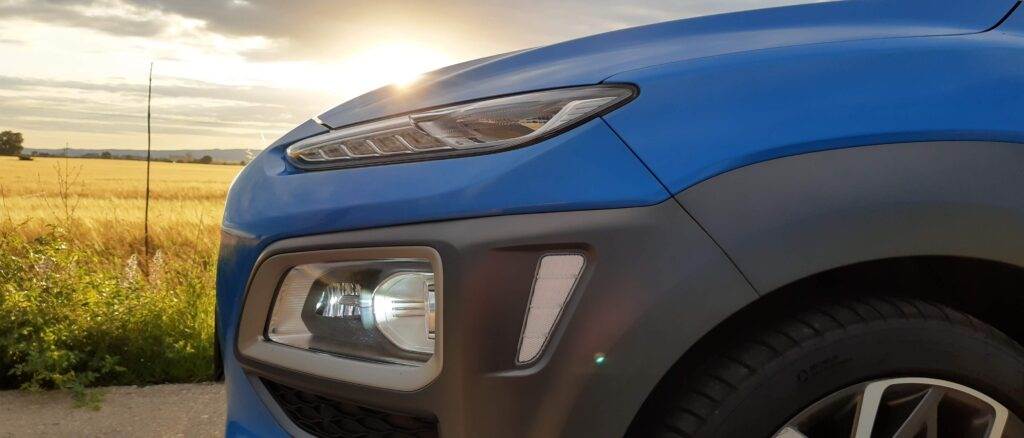
Compared to the other versions, the Hyundai Kona Hybrid also has a reduced fuel tank to 38 liters. On the contrary, a Li-Pol battery with a capacity of 1.56 kWh was added, which of course does not have the possibility of external charging, but only excess energy from braking or from the internal combustion engine is stored in it when lower power is needed. The advantage is that the luggage compartment and the legs of the rear passengers did not suffer from space damage thanks to this. A plug-in hybrid version is not expected for the Kona model yet.
According to the price list, the price for the Style equipment is €27,490 including VAT, but the current promotional price is €1,500 lower. The amount for such a car is not exactly low, but for it you get a well-equipped, stylish crossover that can drive relatively briskly and economically. Especially in the city and in the districts.
| Technical specifications | Hyundai Kona Hybrid |
| Engine type: | Petrol (electric) |
| Cylinders / valves: | 4 / 16 |
| Displacement (ccm): | 1373 |
| Highest power (kW(k) / rpm) | System performance 104 (141) |
| The highest twist. torque (Nm / rpm): | 147 / 4000 ( 170 ) |
| Gearbox: | 6-speed automatic |
| Acceleration 0 – 100 km/h (s): | 11.2 |
| Combined consumption – WLTP (l/100 km): | 3.9–6.0 |
[rl_gallery id=”9943″]

